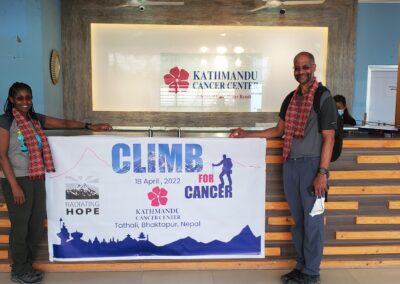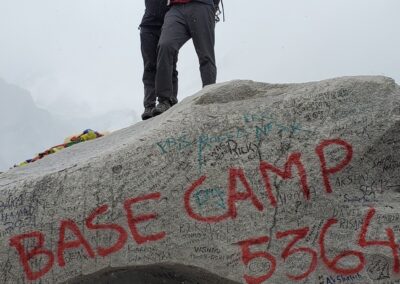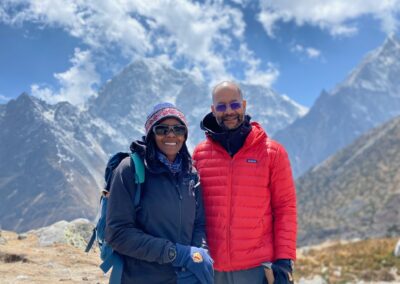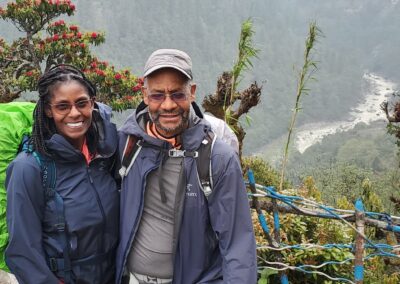Nepal Diary
by Trent & Sheri Boggs
In April 2022, we embarked on a trekking expedition to the Mount Everest base camp in Nepal, alongside a group of trekkers and climbers from the United States and Canada. This journey was organized by Radiating Hope, with the aim of raising funds for the Katmandu Cancer Treatment Center. We successfully raised $10,000 for the center.
Our adventure commenced in Kathmandu, where we met our guide and took two days to recuperate from our journey to Nepal. Following this, we boarded a short flight to Lukla, situated at an elevation of 9,317 ft. within the Sagarmatha National Park. Unfortunately, our trekking gear was not on the same flight and had to be sent the following day. From Lukla, we hiked to Phakding (elevation: 8,700 ft). After an overnight stay at Phakding, our gear finally caught up with us, and we proceeded to Namche Bazar (elevation: 11,280 ft.) amidst a downpour.
We spent two nights at Namche Bazar before heading to Tengboche (elevation: 12,694 ft.). At this point, some members of our group started to feel the effects of the altitude. Nevertheless, we pressed on to Dingboche (elevation: 14,300 ft.) and then Lobuche (elevation: 16,207 ft.). After six days, we spent a restless night at Gorak Shep (elevation: 17,000 ft.) and reached the Everest base camp (elevation: 17,594 ft.) the following day.
After celebrating our achievement, we took a helicopter back to Namche Bazar and hiked back to Lukla. Following a night’s rest at Lukla, we flew back to Kathmandu and spent another day recovering before returning to our home in Alaska.
This expedition was truly a once-in-a-lifetime experience. The beauty of Nepal and the kindness and resilience of its people left a lasting impression on us. Despite being avid hikers (Sheri and I) in the Alaskan mountains, the strength and beauty of Nepal uniquely touched our souls.
We gleaned some valuable insights during our trip that could be beneficial for U.S. travelers planning a trip to Nepal. Here are our key takeaways:
-
- Visa Application Challenges: U.S. citizens are advised to complete their Nepal visa application online prior to their travel. Upon arrival at Tribhuvan International Airport in Kathmandu Nepal, they will need to present this visa application form. Although there are computer stations at the airport terminal for completing the application, these can occasionally be out of service, leading to long wait times. We experienced such a situation during our trip, which resulted in an extended application process. To circumvent potential delays, we advise travelers to complete their visa application form ahead of time and bring a printed copy with them. This preparation can significantly speed up the process. Furthermore, we observed that the Nepali customs agents did not speak English, which posed challenges when seeking assistance with the application at the airport.
-
- Prepare for Dealing with Lost or Delayed Baggage: Be prepared for potential loss or delay of baggage on long flights to Nepal. It’s beneficial to remain calm and have someone proficient in Nepali to communicate with the airport baggage handlers.
-
- Arranging Pick-Up for English-Speaking Travelers: For those visiting Kathmandu for the first time, pre-arranging a pick-up can significantly ease the initial culture shock. During our trip, we faced a 2-hour delay at customs and encountered considerable confusion and communication challenges regarding our lost baggage. The situation was quite hectic upon exiting the airport, and without a pre-arranged pick-up, reaching the hotel would have been an additional hassle. Fortunately, we had arranged for a guide who met us curbside, providing much-needed relief from the stressful situation. Hence, we strongly recommend arranging for a guide to pick up travelers from the airport.
-
- Staying at Hotel: Staying at a high-quality hotel, equivalent to a 4-star hotel in the US, can help reduce stress. This is particularly beneficial for travelers with limited international travel experience.
-
- Staying at Hotel: Staying at a high-quality hotel, equivalent to a 4-star hotel in the US, can help reduce stress. This is particularly beneficial for travelers with limited international travel experience.
-
- Learning the Local Language: Having a basic understanding of Nepali can significantly enrich the travel experience. One of our team members had a basic understanding of Nepali, which greatly enhanced their journey. We strongly encourage travelers to learn some Nepali.
-
- Drinking Water: It’s recommended that travelers not drink tap water or water served in a glass in a restaurant/hotel during their visit to Nepal. It is not because the water there is not good. It is due to the body not being habituated to the local drinking water. US travelers should be prepared to purchase bottled drinking water throughout their stay.
-
- Preparation for Trekking: If planning to trek, travelers should carry small bills to purchase snacks and water in the villages they pass through.
-
- Importance of a Good Guide: If you’re not fluent in Nepali, having a well-prepared tour manager or trekking guide is crucial.
Thank you for the opportunity to share our journey. Namaste!






